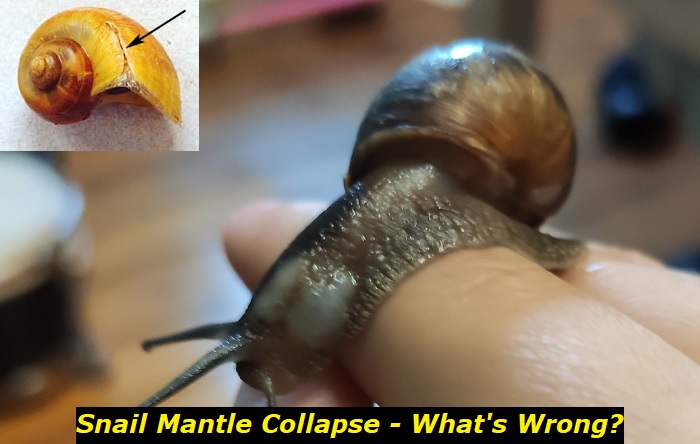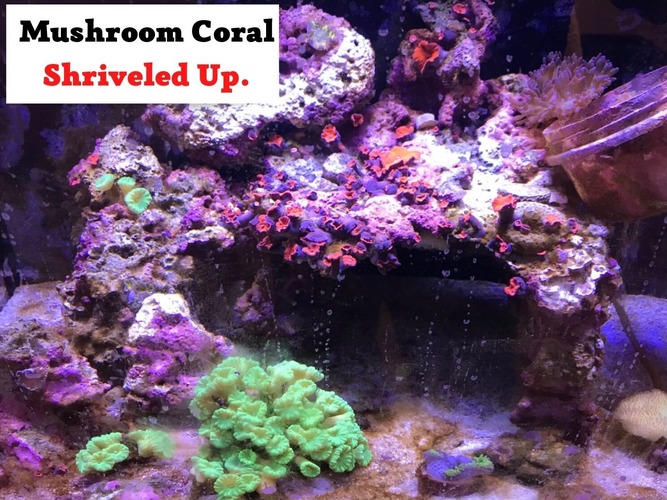The mantle is one of the vital muscles in a snail. It does more than hold the structure of the snail in place; It helps the snail carry out respiratory functions easily by providing the support the snail needs so that its lungs are not collapsed.
So, mantle collapse is one of those eerie topics that every pet owner should know about and how to prevent its possible causes.
Here’s an article that discusses mantle collapse from a practical point of view. Read on to learn about how to handle it.

What Is Snail Mantle Collapse
Snail mantle collapse is a mystery for pet snail keepers, farmers, and scientific researchers.
This mysterious condition usually involves the detachment of the snail from its mantle, leading to many other severe health conditions.
The snail mantle is a muscular sac that attaches to the snail’s shell. This sac holds many delicate organs, including the lungs and gills.
It is the muscle that connects the muscular snail’s foot and its head to its shell. The mantle is also responsible for secreting the material that the snail uses to build its shell.
Snail mantle collapse is a step further from an ordinary tear. It is the partial or complete detachment of the mantle from the shell.
Once the detachment is complete, the snail begins to struggle to breathe because its lunglike pulmonary cavity, which is responsible for respiration underwater, is located in the mantle. The collapse will compromise the ease of breathing, usually leading to their death in a few days.
What Causes Snail Mantle Collapse?
There are no known causes for this mysterious condition. However, many experienced aquarists have reported several possibilities that can cause snail mantis collapse from their experience.
Some of these possible causes include the following:
- General swelling as a reaction to toxic substances
- A rapid change in the water parameters
- A tear in the mantle that worsens over time and eventually leads to a full snail mantle collapse
The tear in the mantle of a snail may be from another snail or group of snails pulling its shell. It may also result from bad handling, such as when a person forcefully pulls on the shell.
This is not uncommon as you may often find snails sucking on themselves with another underneath. They may pile up for a “snail orgy” on a smaller helpless snail, leading to mantle collapse.
Some aquarists have reported similar incidents where the snail squished underneath became very swollen the next day and had its mantle slipping out of its shell. You want to watch out for any possible snail orgies and ensure that unevenly matched snails are removed from the pile.
Do not drag any snail out of the pile. Dragging puts some pressure on the mantle and can lead to a tear. You do not want to cause a tear, as tears will eventually lead to a full collapse.
Another possible and concerning cause for this disturbing health condition is the presence of parasitic nematodes in the snail’s shell. These parasitic nematodes usually occupy the mantle and shell region and survive on the connective tissue. This often leads to a tear in the mantle, which eventually worsens and becomes a complete mantle collapse.
These parasitic nematodes are usually members of the Angiostoma genus in the Angiostomatidae family. These parasitic nematode species include Angiostoma aspersae, Angiostoma asamati, Angiostoma stammeri, etc.
The Angiostoma aspersae, for instance, is a notorious snail parasite. It is usually found in its adult stage, occupying the mantle cavity of the aquatic snail, where it produces larvae in the mantle cavity. This nematode species is usually large, about 2mm large.
Since the larvae are placed between the shell and the mantle, they can often evict the snail from the shell.
Can I Treat Snail Mantle Collapse
Although rare, there have been reports where only the snail’s shell becomes fully detached from its mantle, but the mantle was intact. Usually, you will find a snail with this condition moving around without its shell. But this is very rare.
Generally, it will be challenging to reattach the snail’s mantle back to the roof of its shell. There is hardly any report of anyone or an aquarist’s success in treating snail mantle collapse in aquatic snails.
Many aquarists usually find it easier to treat a minor tear in the mantle with castor oil, as many land snail keepers do. But a full-blown mantle collapse is usually fatal.
However, the hard truth is that you cannot treat snail mantle collapse in aquatic snails. There has been no report of any successful treatment so far. Also, connecting the muscle back to the shell will be challenging. The best you can do as an aquatic snail owner is to help your snail through its last days.
Perhaps, the best way to handle snail mantle collapse is to avoid any possible cause as much as possible and to quickly treat any tear in the mantle to prevent any possible swelling. This is a great way to prevent mantle collapse because the inflammation of the snail will lead to the mantle collapsing, which will ultimately lead to the snail’s death.
How Can I Treat a Tear in the Mantle?
Again, there is no known or recommended treatment for this medical condition. But from the experience of some experienced aquatic snail keepers, you can use castor oil to reduce the inflammation, which seems to be the ultimate cause of death in snails with snail mantle collapse.
Some snail keepers who used it to prevent any infection in the tear found that this anti-fungal and antibacterial treatment helped their snail control the situation.
You want to put the snail in a quarantine tank with no substrate. Oil the rim of the snail shell every day. As you do, ensure to notice any sign of improvement.
Again, there is no known treatment for this condition. These snail owners may have just been lucky to have had some success in handling the situation. You may not have the same outcome. But it is worth trying if you find your snail with a tear in its mantle.
Can My Snail Retract Back Into Its Shell?
It is virtually impossible to have the snail retract back into its shell after fully becoming detached from its shell. Before the collapse, the mantle was the muscular part of the snail that attached the snail’s body to its shell.
The collapse is, therefore, a disconnection between the snail’s body and the shell. What usually happens is that the snail can’t stay in the shell again after the snail mantle collapse.
What will follow is a painful exit. The mantle is a protective sac that holds vital organs and contributes to a balanced structure as it holds the snail’s body to the shell. This allows the snail to breathe well with its lungs and gills.
Normally, the mantle is lined on the interior part of the shell wall. There is only a thin layer of slime and liquid between the nail’s body and the shell. Hence, when the mantle becomes disconnected from the shell, it collapses.
This collapse will affect the proper functioning of the lungs because the lungs will also collapse in the absence of structural support. Apart from the lungs, the gills will also suffer a decrease in functionality because of the mantle collapse.
The snail may survive for a few weeks, but it is, in fact, only going through excruciating pain as it will find it increasingly difficult to breathe day by day. In the end, the snail will ultimately die.
Snail mantle collapse is still a mystery, and there is still no known cure or treatment for this condition. No one knows, for a certainty, any precise cause for the loosening of the mantle from the shell.
Should I Euthanize the Snail?
Many aquarists consider easing the pain of a snail suffering from snail mantle collapse. The choice to help your pet by stopping the pain with euthanization is a personal choice.
The concerning factor that often makes aquarists take this step is when the snail can no longer move around.
But it would be best to wait for a couple of days if all your snail has is a tear. You want to treat the tear with castor oil to prevent inflammation.
If your snail is dealing with a full mantle collapse, you can choose to euthanize it early before it begins to exercise symptoms of excruciating pain and stress.
If you choose to euthanize the affected snail, it would be best to first use a sedative. Snails are often attracted to beer. You can use beer as a sedative. The snail will keep absorbing it until it passes out.
After it passes out, you can freeze the unconscious snail to death. This way, you can help it avoid the pain and, ultimately, the pain that will follow the detachment of its mantle.
- Snail Mantle Collapse – Here’s What Every Pet Owner Should Know - April 2, 2023
- Algaefix Killed My Fish – What Have I Done Wrong? - March 2, 2023
- How Long Can Live Rock Be Out of Water? And What Will Happen Then? - February 2, 2023




